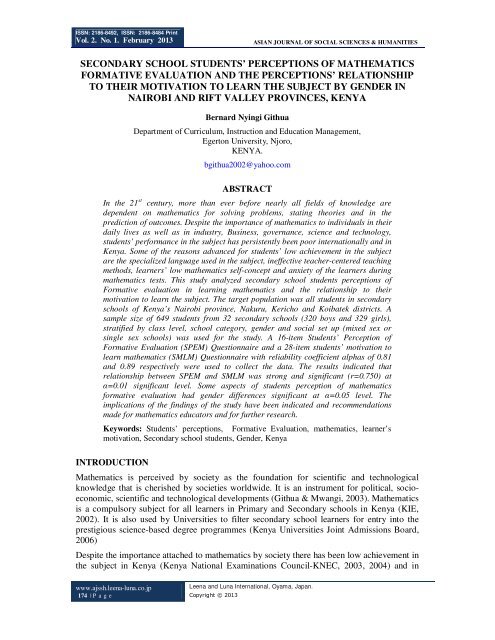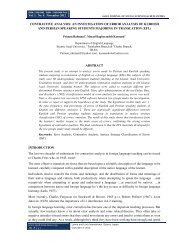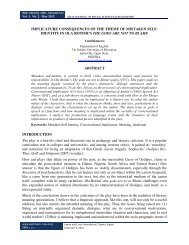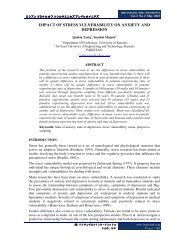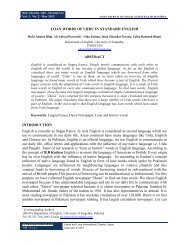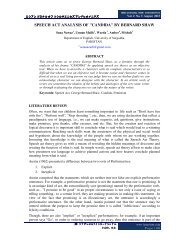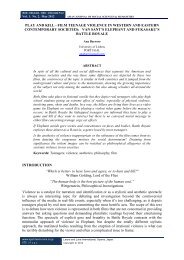Full Paper - Asian Journal of Social Sciences and Humanities (AJSSH)
Full Paper - Asian Journal of Social Sciences and Humanities (AJSSH)
Full Paper - Asian Journal of Social Sciences and Humanities (AJSSH)
Create successful ePaper yourself
Turn your PDF publications into a flip-book with our unique Google optimized e-Paper software.
ISSN: 2186-8492, ISSN: 2186-8484 Print<br />
Vol. 2. No. 1. February 2013<br />
ASIAN JOURNAL OF SOCIAL SCIENCES & HUMANITIES<br />
SECONDARY SCHOOL STUDENTS’ PERCEPTIONS OF MATHEMATICS<br />
FORMATIVE EVALUATION AND THE PERCEPTIONS’ RELATIONSHIP<br />
TO THEIR MOTIVATION TO LEARN THE SUBJECT BY GENDER IN<br />
NAIROBI AND RIFT VALLEY PROVINCES, KENYA<br />
Bernard Nyingi Githua<br />
Department <strong>of</strong> Curriculum, Instruction <strong>and</strong> Education Management,<br />
Egerton University, Njoro,<br />
KENYA.<br />
bgithua2002@yahoo.com<br />
ABSTRACT<br />
In the 21 st century, more than ever before nearly all fields <strong>of</strong> knowledge are<br />
dependent on mathematics for solving problems, stating theories <strong>and</strong> in the<br />
prediction <strong>of</strong> outcomes. Despite the importance <strong>of</strong> mathematics to individuals in their<br />
daily lives as well as in industry, Business, governance, science <strong>and</strong> technology,<br />
students’ performance in the subject has persistently been poor internationally <strong>and</strong> in<br />
Kenya. Some <strong>of</strong> the reasons advanced for students’ low achievement in the subject<br />
are the specialized language used in the subject, ineffective teacher-centered teaching<br />
methods, learners’ low mathematics self-concept <strong>and</strong> anxiety <strong>of</strong> the learners during<br />
mathematics tests. This study analyzed secondary school students perceptions <strong>of</strong><br />
Formative evaluation in learning mathematics <strong>and</strong> the relationship to their<br />
motivation to learn the subject. The target population was all students in secondary<br />
schools <strong>of</strong> Kenya’s Nairobi province, Nakuru, Kericho <strong>and</strong> Koibatek districts. A<br />
sample size <strong>of</strong> 649 students from 32 secondary schools (320 boys <strong>and</strong> 329 girls),<br />
stratified by class level, school category, gender <strong>and</strong> social set up (mixed sex or<br />
single sex schools) was used for the study. A 16-item Students’ Perception <strong>of</strong><br />
Formative Evaluation (SPEM) Questionnaire <strong>and</strong> a 28-item students’ motivation to<br />
learn mathematics (SMLM) Questionnaire with reliability coefficient alphas <strong>of</strong> 0.81<br />
<strong>and</strong> 0.89 respectively were used to collect the data. The results indicated that<br />
relationship between SPEM <strong>and</strong> SMLM was strong <strong>and</strong> significant (r=0.750) at<br />
α=0.01 significant level. Some aspects <strong>of</strong> students perception <strong>of</strong> mathematics<br />
formative evaluation had gender differences significant at α=0.05 level. The<br />
implications <strong>of</strong> the findings <strong>of</strong> the study have been indicated <strong>and</strong> recommendations<br />
made for mathematics educators <strong>and</strong> for further research.<br />
Keywords: Students’ perceptions, Formative Evaluation, mathematics, learner’s<br />
motivation, Secondary school students, Gender, Kenya<br />
INTRODUCTION<br />
Mathematics is perceived by society as the foundation for scientific <strong>and</strong> technological<br />
knowledge that is cherished by societies worldwide. It is an instrument for political, socioeconomic,<br />
scientific <strong>and</strong> technological developments (Githua & Mwangi, 2003). Mathematics<br />
is a compulsory subject for all learners in Primary <strong>and</strong> Secondary schools in Kenya (KIE,<br />
2002). It is also used by Universities to filter secondary school learners for entry into the<br />
prestigious science-based degree programmes (Kenya Universities Joint Admissions Board,<br />
2006)<br />
Despite the importance attached to mathematics by society there has been low achievement in<br />
the subject in Kenya (Kenya National Examinations Council-KNEC, 2003, 2004) <strong>and</strong> in<br />
www.ajssh.leena-luna.co.jp<br />
174 | P a g e<br />
Leena <strong>and</strong> Luna International, Oyama, Japan.<br />
Copyright © 2013
アシエン ヅロナル オホ ソセアル サイネセズ アナド ヒウメニテズ<br />
ISSN: 2186-8492, ISSN: 2186-8484 Print<br />
Vol. 2. No. 1. February 2013<br />
other parts <strong>of</strong> the world as indicated by the Third Trends in Mathematics <strong>and</strong> Science study<br />
(TIMSS) <strong>of</strong> 2004 (Gonzales, Guzman <strong>and</strong> Jocelyn, 2004).<br />
A multiple <strong>of</strong> causes for the students low achievement in mathematics has been attributed to:<br />
difficulty in underst<strong>and</strong>ing the specialized mathematical language (Barton, 2002; Oyaya &<br />
Njuguna, 1999; Battisa & Clements, 1996; O’connor, 2000), ineffective, teacher-centered<br />
teaching methods <strong>and</strong> learners’ negative attitudes towards the subject (Miheso, 2012; Ngeno<br />
& Changeiywo, 2007), Learners lack <strong>of</strong> motivation to learn the subject(Githua & Mwangi,<br />
2003) <strong>and</strong> lack <strong>of</strong> mathematics syllabus coverage (Shikuku, 2009).<br />
This study analyzed secondary school students’ perceptions <strong>of</strong> formative evaluation in<br />
mathematics classrooms in order to determine whether those perceptions have any<br />
relationship with students’ motivation to learn mathematics. Gender differences in the<br />
student’s perceptions <strong>of</strong> evaluation in mathematics were also studied because it could be an<br />
indicator <strong>of</strong> the gender differences in mathematics achievement that exist among secondary<br />
school students in Kenya.<br />
In this study students’ perception <strong>of</strong> formative evaluation in mathematics referred to their<br />
opinions, feelings, emotions <strong>and</strong> judgments <strong>of</strong> the importance, usefulness <strong>and</strong> meaningfulness<br />
<strong>of</strong> teachers’ actions, procedures, practices <strong>and</strong> social climate in which they assess <strong>and</strong><br />
monitor students’ mathematics learning.<br />
Evaluation <strong>of</strong> students’ mathematical work involves teachers’ qualitative judgment <strong>of</strong> how<br />
well or how satisfactorily a student is performing or progressing in learning mathematics<br />
tasks (Hamachek, 1995). According to Dembo (1994) there are different types <strong>of</strong><br />
instructional evaluation that a teacher can carry out. They include: placement evaluation<br />
which is aimed at finding out students’ entry behavior before beginning instruction; formative<br />
evaluation which provides ongoing feedback to teachers <strong>and</strong> students regarding successes <strong>and</strong><br />
failures during instruction; diagnostic evaluation which attempts to find out specific learning<br />
difficulties that a student may have on specific mathematical facts, algorithms, concepts,<br />
principles or problem solving.<br />
There is also summative evaluation, which comes at the end <strong>of</strong> instruction in a school term or<br />
year. It assesses the extent <strong>of</strong> attainment <strong>of</strong> instructional objectives, provides information to<br />
guide grading <strong>of</strong> students <strong>and</strong> evaluates teacher effectiveness (Dembo, 1994).<br />
This study focused on formative evaluation in which mathematics teachers give oral written<br />
comments <strong>and</strong> grades as feedback, to indicate misconceptions, or correctness/incorrectness <strong>of</strong><br />
mathematical performance (Dean, 1982). Formative evaluation requires that the teacher<br />
collects a lot <strong>of</strong> information on learners’ performance through observations, classroom oral<br />
questioning, homework assignments, quizzes as well as informal inventories (Ebee & Frisbie,<br />
1991).<br />
Operationally in this study students’ perceptions <strong>of</strong> formative evaluation in mathematics was<br />
defined as a composite variable represented by a mean score <strong>of</strong> the non-missing students<br />
responses on 16 items which were used to measure the construct on a 1 to 5 point Likert-type<br />
survey instrument.<br />
Students perception <strong>of</strong> formative evaluation in mathematics included: perceptions <strong>of</strong><br />
difficulty/ease <strong>of</strong> mathematical tasks; importance, usefulness, meaningfulness <strong>and</strong><br />
contribution <strong>of</strong> mathematical assignments <strong>and</strong> tests to mathematics learning; students’<br />
liking/dislike <strong>of</strong> teachers’ posting <strong>of</strong> mathematics grades on notice boards; stiff competition<br />
in mathematics performance; pressure <strong>of</strong> time to complete mathematical tests; pressure <strong>of</strong><br />
( 株 ) リ リ<br />
アンドル リ ル ル ル ル リ ル ル リ ル<br />
小 山 市 、 日 本 .<br />
www. leena-luna.co.jp<br />
P a g e | 175
ISSN: 2186-8492, ISSN: 2186-8484 Print<br />
Vol. 2. No. 1. February 2013<br />
ASIAN JOURNAL OF SOCIAL SCIENCES & HUMANITIES<br />
time to complete mathematical assignments; <strong>and</strong> students’ experience <strong>of</strong> worry or anxiety<br />
created by mathematical tests.<br />
Motivation to learn subject matter in this study referred to the internal drive or external force<br />
that initiate, maintain or causes to cease a learner’s behaviour towards learning subject matter<br />
that is targeted <strong>and</strong> is the learner’s goal. (Husen & Postlethwaite, 1985). There are two types<br />
<strong>of</strong> motivation to learn: intrinsic; <strong>and</strong> extrinsic motivation (Biehler & Snowman, 1997; Good<br />
& Brophy 1995).intrinsic motivation is a response to individuals internal needs for example<br />
personal enjoyment in learning a task, or interest in a subject that is inherently interesting<br />
(Good & Brophy, 1995).<br />
Extrinsic motivation is directed towards getting rewards that are external to the learner such<br />
as teachers’ encouragement, positive feedback on learner’s performance on skills or tasks.<br />
Due to the importance educators attach to motivation in the learning process this study<br />
wanted to find out whether students’ perception <strong>of</strong> formative evaluation in mathematics<br />
which goes on in secondary school mathematics classrooms are related to learners motivation<br />
to learn mathematics.<br />
Studies conducted in other parts <strong>of</strong> the world indicate that one <strong>of</strong> the purposes <strong>of</strong> evaluation is<br />
to cultivate motivation in learners (Shiton, Kenwood, Moss <strong>and</strong> Phimpton, 1985; Berliner <strong>and</strong><br />
Cassanova, 1988). There is however limited such studies that having been carried out in<br />
Kenya. The present study was therefore warranted.<br />
STATMENT OF PROBLEM<br />
The importance <strong>of</strong> mathematics to an individual <strong>and</strong> society is acknowledged worldwide.<br />
Unfortunately, learners’ performance in the subject at national examinations at the end <strong>of</strong><br />
primary <strong>and</strong> secondary schools education is worrying all over the globe. Among the reasons<br />
given for the dismal mathematics achievement is lack <strong>of</strong> students’ motivation to learn<br />
mathematics <strong>and</strong> hence their low achievement in it. In an attempt to seek reasons for learners'<br />
low motivation this study investigated whether students’ perception <strong>of</strong> formative evaluation<br />
in mathematics has any relationship with their motivation to learn the subject by gender.<br />
PURPOSE OF THE STUDY<br />
The study sought to analyze secondary school students’ perceptions <strong>of</strong> formative evaluation<br />
in mathematics classrooms by gender <strong>and</strong> find out whether those perceptions are related to<br />
students motivation to learn mathematics.<br />
OBJECTIVES OF THE STUDY<br />
1. To find out whether students’ perceptions <strong>of</strong> formative evaluation in mathematics is<br />
related to the achievement in the subject.<br />
2. To establish whether there are genders differences in students’ perception <strong>of</strong><br />
Formative evaluation in Mathematics.<br />
NULL HYPOTHESES<br />
The following are the two hypotheses <strong>of</strong> the study which were tested at 0.05α – level.<br />
H 0 1: There is no statistically significant relationship between secondary school students’<br />
perceptions <strong>of</strong> formative evaluation in mathematics classrooms <strong>and</strong> their motivation to<br />
learn mathematics.<br />
H 0 2: There are no statistically significant gender differences in students’ perceptions <strong>of</strong><br />
formative evaluation in mathematics classrooms.<br />
www.ajssh.leena-luna.co.jp<br />
176 | P a g e<br />
Leena <strong>and</strong> Luna International, Oyama, Japan.<br />
Copyright © 2013
アシエン ヅロナル オホ ソセアル サイネセズ アナド ヒウメニテズ<br />
ISSN: 2186-8492, ISSN: 2186-8484 Print<br />
Vol. 2. No. 1. February 2013<br />
Conceptual Framework<br />
The conceptual framework <strong>of</strong> the study shown diagrammatically in Figure 1 was based on<br />
systems theory as espoused by Ayot <strong>and</strong> Patel (1987) as well as Gerlach <strong>and</strong> Ely (1980). The<br />
influence <strong>of</strong> students’ motivation to learn mathematics (dependent variable) by their<br />
perceptions <strong>of</strong> formative evaluation in mathematics classrooms (independent variable) was<br />
hypothesized to be a dynamic systematic process in which there was also an extraneous<br />
variable <strong>of</strong> students’ <strong>of</strong> gender which could affect students’ motivation to learn mathematics.<br />
The hypothesized relationship <strong>of</strong> the variables is shown in Figure 1.<br />
METHODOLOGY<br />
Research Design<br />
The expost-facto research design was used in this study in which correlation/regressional<br />
analysis were employed to analyze the data. This design was appropriate for the study<br />
because the study aimed at obtaining important information on the status <strong>of</strong> specific<br />
phenomenon after some naturally occurring treatment without any manipulation <strong>of</strong> the<br />
situation (Koul, 1993).<br />
Population<br />
The target population <strong>of</strong> the study was all students in secondary schools (Forms I – IV) in<br />
Nairobi province, Nakuru, Kericho <strong>and</strong> Koibatek districts in Kenya.<br />
Students’ Perceptions <strong>of</strong><br />
Formative Evaluation in<br />
Mathematics on its:<br />
• Importance<br />
• Usefulness<br />
• Meaningfulness<br />
• Extent <strong>of</strong> contribution to<br />
learning<br />
• Disliking or liking<br />
• Anxiety producing<br />
• Building <strong>of</strong> pressure <strong>of</strong> time<br />
to complete tasks<br />
• Creating negative<br />
competition among learners<br />
Gender<br />
Student’s<br />
motivation to<br />
learn mathematics<br />
Independent variables extraneous variables Dependent variables<br />
Figure 1. The conceptual Framework <strong>of</strong> the relationship <strong>of</strong> variables in the study<br />
Sampling Procedure <strong>and</strong> Sample Size<br />
A sample <strong>of</strong> 649 students (320 boys, 329 girls) was obtained from 32 secondary schools (19<br />
public, 13 private) stratified by school category (provincial or district) sponsorship (public,<br />
private) <strong>and</strong> by gender (single-sex or co-educational) <strong>and</strong> class level. Table 2 <strong>and</strong> Table 3<br />
( 株 ) リ リ<br />
アンドル リ ル ル ル ル リ ル ル リ ル<br />
小 山 市 、 日 本 .<br />
www. leena-luna.co.jp<br />
P a g e | 177
ISSN: 2186-8492, ISSN: 2186-8484 Print<br />
Vol. 2. No. 1. February 2013<br />
ASIAN JOURNAL OF SOCIAL SCIENCES & HUMANITIES<br />
show how the schools <strong>and</strong> the students were sampled from rural, urban <strong>and</strong> the different<br />
categories <strong>of</strong> schools respectively.<br />
Table 2. Distribution <strong>of</strong> Sample Schools in the Twelve Strata <strong>of</strong> Secondary Schools in Nairobi<br />
Province <strong>and</strong> Rift Valley Province (Nakuru, Kericho <strong>and</strong> Koibatek Districts)<br />
Provide/<br />
District<br />
No. <strong>of</strong> Schools<br />
No. In Sample <strong>of</strong> Each Stratum <strong>of</strong><br />
Public Schools<br />
Boys<br />
No. In Sample <strong>of</strong> Each Stratum <strong>of</strong><br />
Private Schools<br />
RURAL URBAN RURAL URBAN<br />
Girls<br />
Mixed<br />
Boys<br />
Girls<br />
Nairobi 82 - - - 2 2 2 - - - 2 1 2 11<br />
Nakuru 104 1 1 2 - 1 1 1 1 1 - 1 1 11<br />
Kericho 51 1 1 2 - - - - 1 1 - - - 6<br />
Koibatek 19 1 1 1 - - - - 1 - - - - 4<br />
TOTALS 256 3 3 5 2 3 3 1 3 2 2 2 3 32<br />
Mixed<br />
Boys<br />
Girls<br />
Mixed<br />
Boys<br />
Girls<br />
Mixed<br />
Total<br />
Table 3. Distribution <strong>of</strong> Sampled Students in the Twelve Strata <strong>of</strong> Secondary Schools in Nairobi<br />
Province, Nakuru, Kericho <strong>and</strong> Koibatech Districts<br />
Provide/<br />
District<br />
No. <strong>of</strong> Math<br />
Students in<br />
Province/District<br />
No. In Sample <strong>of</strong> Each Stratum<br />
<strong>of</strong> Public Schools<br />
Boys<br />
No. In Sample <strong>of</strong> Each Stratum<br />
<strong>of</strong> Private Schools<br />
RURAL URBAN RURAL URBAN<br />
Girls<br />
Mixed<br />
Boys<br />
Girls<br />
Nairobi 26,245 - 57 40 42 - - - 36 24 39 238<br />
Nakuru 36,959 16 16 65 - 16 16 32 16 25 - 17 21 240<br />
Kericho 12,897 20 16 40 - - - - 16 17 - - - 109<br />
Koibatek 5,340 12 14 24 - - - - 12 - - - - 62<br />
TOTALS 81,441 48 46 129 57 56 58 32 44 42 36 41 60 649<br />
Source: M.O.E (1999) Provincial Education Officer records (Nairobi <strong>and</strong> Rift Valley Provinces)<br />
Instruments<br />
A 16 – item, 5 point liker type instrument was used to measure students’ perceptions <strong>of</strong><br />
formative evaluation in mathematics (SPEM) classrooms. A 28-item, 5 point liker type<br />
instrument was also used to measure students’ motivation to learn mathematics (SMLM).<br />
Both instruments were validated by five experts from the department <strong>of</strong> Curriculum,<br />
Instruction <strong>and</strong> Education Management <strong>of</strong> Egerton University. The two instruments had<br />
reliability coefficients alphas <strong>of</strong> 0.81 <strong>and</strong> 0.89 for SPEM <strong>and</strong> for SMLM respectively. Data<br />
was analyzed by calculating Pearson’s moment correlation coefficient between SPEM <strong>and</strong><br />
SMLM, regression analysis <strong>and</strong> the ANOVA procedure.<br />
Mixed<br />
Boys<br />
Girls<br />
Mixed<br />
Boys<br />
Girls<br />
Mixed<br />
Total<br />
www.ajssh.leena-luna.co.jp<br />
178 | P a g e<br />
Leena <strong>and</strong> Luna International, Oyama, Japan.<br />
Copyright © 2013
アシエン ヅロナル オホ ソセアル サイネセズ アナド ヒウメニテズ<br />
ISSN: 2186-8492, ISSN: 2186-8484 Print<br />
Vol. 2. No. 1. February 2013<br />
RESULTS<br />
Out <strong>of</strong> a total <strong>of</strong> 649 students who were involved in the study, 648 responded to the 16 items,<br />
which were used to measure their perceptions <strong>of</strong> formative evaluation in mathematics.<br />
Relationship between Students’ Perceptions <strong>of</strong> Formative Evaluation in Mathematics<br />
<strong>and</strong> Their Motivation to Learn Mathematics<br />
Table 4. Relationship between SPEM <strong>and</strong> SMLM.<br />
SMLM SPEM (N=648)<br />
SMLM 1 0.750**<br />
SPEM 0.750** 1<br />
**Shows that r, the correlation coefficient is significant at α = 0.01 level.<br />
Results from Table 4 indicate that there is a strong <strong>and</strong> statistically significant relationship<br />
(r=0.750) between students perceptions <strong>of</strong> formative evaluation in secondary school<br />
mathematics classrooms <strong>and</strong> their motivation to learn mathematics at α = 0.01 significance<br />
level. The hypothesis <strong>of</strong> the study that there is no statistically significant relationship between<br />
SMLM <strong>and</strong> SPEM was therefore rejected. This finding is supported by research studies in<br />
USA (Berlinger <strong>and</strong> Cassanova, 1988) which showed that evaluation in subject matter in the<br />
course <strong>of</strong> instruction enhances <strong>and</strong> is related to student’s intrinsic motivation.<br />
To determine the proportion <strong>of</strong> variance in student’s motivation to learn mathematics<br />
explained by their perceptions <strong>of</strong> formative evaluation in mathematics, students’ motivation<br />
to learn mathematics was regressed (stepwise) on students’ perceptions <strong>of</strong> evaluation in<br />
mathematics.<br />
Using a probability <strong>of</strong> F-to-enter less or equal to .50 <strong>and</strong> a probability <strong>of</strong> F-to-remove greater<br />
or equal to 0.1 the regression output <strong>of</strong> the independent <strong>and</strong> the dependent variables as shown<br />
in Table 5.<br />
Table 5. Regression <strong>of</strong> Students’ Motivation to Learn Mathematics on their Perceptions <strong>of</strong><br />
Formative Evaluation in Mathematics-Stepwise Entry (N=646, valid listwise)<br />
Variables R R-square<br />
Adjusted<br />
R -square<br />
Constant 0.63 5.74 0.000<br />
Students’ perceptions <strong>of</strong><br />
evaluation in mathematics<br />
Beta<br />
t<br />
Sig<br />
(P)<br />
0.75 0.56 0.56 0.82 28.75 0.000<br />
F=826.547 R 2 =0.5625 AdjR 2 =0.56 Prob(˃)=0.000 df=(1,644)<br />
The simple linear regression output shown on table 5 suggests that the linear equation relating<br />
students’ motivation to their perception <strong>of</strong> formative evaluation in mathematics is <strong>of</strong> the<br />
form:<br />
0.63<br />
SMLM =<br />
t = 5.742<br />
+ 0.82 × ( SPEM )<br />
( ) ( t = 28.750)<br />
... Equation1<br />
Adjusted R 2 = 0.562 suggesting that students’ perceptions <strong>of</strong> formative evaluation in<br />
mathematics explains 56.2% <strong>of</strong> the variance in SMLM. The values <strong>of</strong> t for the corresponding<br />
values <strong>of</strong> constant <strong>and</strong> beta (coefficient) in the equation are significant at 0.01. The F – value<br />
( 株 ) リ リ<br />
アンドル リ ル ル ル ル リ ル ル リ ル<br />
小 山 市 、 日 本 .<br />
www. leena-luna.co.jp<br />
P a g e | 179
ISSN: 2186-8492, ISSN: 2186-8484 Print<br />
Vol. 2. No. 1. February 2013<br />
ASIAN JOURNAL OF SOCIAL SCIENCES & HUMANITIES<br />
from ANOVA undertaken for the whole equation is 826.547, significant at 0.01, df = (1,644)<br />
suggesting that R 2 is significantly different from zero <strong>and</strong> the coefficients in the equation are<br />
different from zero. The equation therefore, exists <strong>and</strong> defines a linear relationship between<br />
SMLM <strong>and</strong> SPEM. This further led to the rejection <strong>of</strong> hypothesis one <strong>of</strong> the study. This<br />
suggests a strong significant relationship between students’ perception <strong>of</strong> formative<br />
evaluation <strong>and</strong> their motivation to learn mathematics.<br />
Gender Differences In Secondary School Students’ Perceptions Of Formative<br />
Evaluation In Mathematics Classrooms<br />
Table 6 shows results for hypothesis two <strong>of</strong> the study. The table shows mean scores, SD on<br />
student’s perceptions <strong>of</strong> Formative Evaluation in mathematics by gender.<br />
Table 6. Mean Scores <strong>and</strong> St<strong>and</strong>ard Deviations on Students’ Perceptions <strong>of</strong> Formative<br />
Evaluation in Mathematics by Gender (16 items)<br />
Gender Mean SD N<br />
Male 3.86 0.51 319<br />
Female 3.84 0.50 329<br />
Total 648<br />
Table 6 shows mean scores <strong>and</strong> SD for 648 students. Overall boys had higher mean scores in<br />
SPEM than girls.<br />
The F-value undertaken from ANOVA for mean gender differences in SPEM for all the 16<br />
items taken together was 0.516 at α = 0.473 significant level; df = (1,646) which was not<br />
statistically significant at .05 level <strong>of</strong> significance. This suggested that overall; there is no<br />
statistically significant gender differences in students’ perception <strong>of</strong> formative evaluation in<br />
mathematics.<br />
Analyzing the 16 items that measured students’ perceptions <strong>of</strong> Formative evaluation in<br />
mathematics item by item however revealed that there were gender differences in the<br />
following five items on students’ perceptions <strong>of</strong> Formative evaluation in mathematics scale:<br />
a. I find mathematics tests easy (in favour <strong>of</strong> boys).<br />
b. I find mathematics assignments meaningful (in favour <strong>of</strong> girls)<br />
c. mathematics assignments contribute a lot to the learning <strong>of</strong> mathematics (in favour <strong>of</strong><br />
girls)<br />
d. I usually worry over mathematics tests <strong>and</strong> assignments (in favour <strong>of</strong> boys).<br />
e. I rarely find time for mathematics assignments (in favour <strong>of</strong> boys).<br />
The responses to the positive items in the scale were scored as strongly agree = 5, agree = 4,<br />
undecided = 3, disagree = 2 <strong>and</strong> strongly disagree = 1.<br />
Negative items were scored in the reverse order. Therefore higher scores indicated positivity<br />
<strong>of</strong> students’ perception <strong>of</strong> Formative evaluation in mathematics learning. The results showed<br />
significant gender differences for the five items at α = 0.05 significance level.<br />
The results for items one, three <strong>and</strong> five which were in favour <strong>of</strong> boys suggests that girls find<br />
mathematics tests hard compared with boys, they have more mathematics anxiety to succeed<br />
in the subject than the boys <strong>and</strong> girls rarely find time to do mathematics assignments at home<br />
www.ajssh.leena-luna.co.jp<br />
180 | P a g e<br />
Leena <strong>and</strong> Luna International, Oyama, Japan.<br />
Copyright © 2013
アシエン ヅロナル オホ ソセアル サイネセズ アナド ヒウメニテズ<br />
ISSN: 2186-8492, ISSN: 2186-8484 Print<br />
Vol. 2. No. 1. February 2013<br />
due to domestic chores (Mureithi,2000). Items two <strong>and</strong> three which favoured girls suggests<br />
that girls feel comfortable when they are given mathematical tasks in form <strong>of</strong> assignments<br />
than the boys do.<br />
DISCUSSION<br />
Students’ Perceptions <strong>of</strong> Formative Evaluation in Mathematics <strong>and</strong> their Motivation to<br />
Learn Mathematics<br />
Mathematics educators (Fraser & Gillan, 1972; Shiton, Kenwood, Moss <strong>and</strong> Phimpton, 1985)<br />
agree that among other purposes <strong>of</strong> evaluation in mathematics, the provision <strong>of</strong> motivation to<br />
learn mathematics is critical. The findings <strong>of</strong> this study revealed that there is a strong <strong>and</strong><br />
statistically significant (α = 0.01) relationship (r = .750) between SMLM <strong>and</strong> SPEM in<br />
secondary schools. Furthermore, there is a linear relationship between students’ motivation to<br />
learn mathematics <strong>and</strong> their perceptions <strong>of</strong> evaluation in mathematics. The variation in<br />
SMLM accounted for by SPEM was 56.2% when no other relevant variables were<br />
considered.<br />
The findings in this study are consistent with those in USA by Berliner & Cassanova (1988)<br />
<strong>and</strong> Butler & Nissan (1986) which showed that evaluation <strong>and</strong> giving <strong>of</strong> grades does much to<br />
enhance student’s extrinsic motivation to learn subject matter but can also have a strong<br />
negative effect on students’ intrinsic motivation if evaluation is improperly carried out. The<br />
findings <strong>of</strong> this study concur with the arguments <strong>of</strong> Chinn & Ashcr<strong>of</strong>t (1993) that evaluation<br />
in mathematics is an essential <strong>and</strong> important component <strong>of</strong> learning mathematics. Mwangi &<br />
McCaslin (1994 in their findings on agricultural extension agents in Kenya’s Rift Valley<br />
Province found out that evaluation was one <strong>of</strong> the factors that was related to job motivation<br />
for agricultural extension agents in Rift Valley Province.<br />
Elsewhere, for example, the frequency <strong>of</strong> teacher evaluations, the time teachers spend<br />
correcting tests <strong>and</strong> exercises were fournd to be related to academic achievement <strong>of</strong> upper<br />
primary school pupils in Argentina <strong>and</strong> Columbia (Lockhead & Verspoor, 1991). The time<br />
that teachers spend on monitoring <strong>and</strong> evaluating students’ performance was found to be<br />
related to student’s mathematics achievement in upper primary schools in Swazil<strong>and</strong><br />
(Lockhead & Verspoor, 1991). This study has clearly demonstrated that formative students’<br />
perceptions evaluation in mathematics in secondary schools is related to students’ motivation<br />
to learn mathematics which would lead to higher levels <strong>of</strong> mathematics achievement (Hemke,<br />
1990). Secondary school mathematics teachers should therefore plan carefully for<br />
mathematics quizzes, homework, classroom supervised mathematics work, end term<br />
mathematics tests <strong>and</strong> end-year mathematics examinations in order to increase students<br />
motivation to learn mathematics.<br />
CONCLUSIONS<br />
On the basis <strong>of</strong> the findings <strong>of</strong> this study, the following conclusions were reached.<br />
1. There is a strong <strong>and</strong> significant relationship between students’ perception <strong>of</strong><br />
formative evaluation in mathematics classrooms <strong>and</strong> their motivation to learn<br />
mathematics.<br />
2. Students’ perception <strong>of</strong> formative evaluation in mathematics classrooms accounted<br />
for 56% variation in students’ motivation to learn mathematics when no other<br />
independent variable were considered.<br />
( 株 ) リ リ<br />
アンドル リ ル ル ル ル リ ル ル リ ル<br />
小 山 市 、 日 本 .<br />
www. leena-luna.co.jp<br />
P a g e | 181
ISSN: 2186-8492, ISSN: 2186-8484 Print<br />
Vol. 2. No. 1. February 2013<br />
ASIAN JOURNAL OF SOCIAL SCIENCES & HUMANITIES<br />
3. There are gender differences in the way boys <strong>and</strong> girls perceive some aspects <strong>of</strong><br />
formative evaluation in mathematics classrooms.<br />
IMPLICATIONS<br />
The implications <strong>of</strong> the findings are that teachers should carefully plan <strong>and</strong> administer<br />
mathematics quizzes, out <strong>of</strong> class assignments, supervised classroom mathematics<br />
assignments, end term <strong>and</strong> end year mathematics examinations. The environmental <strong>and</strong> social<br />
conditions in which teachers h<strong>and</strong>le mathematics formative evaluations <strong>and</strong> their feedback to<br />
learners should be conducive for both boys <strong>and</strong> girls. This would enhance the learners’<br />
motivation to learn mathematics.<br />
REFERENCES<br />
Ayot, H. O. & Patel, M. M. (1987). Instructional methods (pp 34 – 53). Nairobi, Kenya:<br />
Kenyatta University.<br />
Barton, M. L. & Heidema, C. (2002). Teaching Reading in mathematics [on line]. Available:<br />
http://www.nwrel.org/msec/resources/singlesources<br />
Barttisa, M. T. & Clements, D. H (1996). Students underst<strong>and</strong>ing <strong>of</strong> Three Dimensional<br />
Rectangular Arrays <strong>of</strong> cubes. In Lester, F. <strong>Journal</strong> <strong>of</strong> Research in mathematics<br />
Education, 27(3). Virginia, Reston.<br />
Berliner, D. & Cassanova, U. (1988). Are grades undermining motivation Instructor, 98(3),<br />
18-19.<br />
Biehler, R. F. & Snowman, J. (1997). Psychology applied to teaching (8 th ed.). Boston:<br />
Houghton Mifflin Co.<br />
Butler, R. & Nisan, M. (1986). Effects <strong>of</strong> no feedback, task related comments, <strong>and</strong> grades on<br />
intrinsic motivation <strong>and</strong> performance. <strong>Journal</strong> <strong>of</strong> Educational Psychology, 78(3),<br />
210–216.<br />
Chin, S. J. & Aschcr<strong>of</strong>t, J. R. (1993). Mathematics for dyslexics: A teaching h<strong>and</strong>book,<br />
London: Whurr publishers Limited.<br />
Dean, P. G. (1982). Teaching <strong>and</strong> Learning mathematics. London Wobum Press.<br />
Dembo, M. H. (1994). Applying educational psychology (5 th ed.). NY: Longman Publishing<br />
Company.<br />
Ebel, R. L. & Frisbie, D. A. (1991). Essentials <strong>of</strong> Educational measurement (5 th ed.). New<br />
Delhi: Prentice – Hall <strong>of</strong> India Private Ltd.<br />
Fraser, W. G. Gillam, J. N. (1972). The principles <strong>of</strong> objective testing in mathematics.<br />
London: Heinemann Educational Books Ltd.<br />
Gerlach V. S. & Ely, D. P. (1980). Teaching <strong>and</strong> media: A systematic approach (2 nd ed.).<br />
Englewood cliffs, NJ: Prentice Hall, Inc.<br />
Githua, B. N. (2000). Factors related to the motivation to learn mathematics among<br />
secondary school students in Kenya’s Nairobi province <strong>and</strong> three Districts <strong>of</strong> Rift<br />
Valley province. Unpublished, Doctoral Thesis, Egerton University, Njoro, Kenya.<br />
Githua B. N. & Mwangi J. G (2003) Students’ mathematics self-concept <strong>and</strong> motivation to<br />
learn mathematics: relationship <strong>and</strong> gender differences among Kenya’s secondary-<br />
www.ajssh.leena-luna.co.jp<br />
182 | P a g e<br />
Leena <strong>and</strong> Luna International, Oyama, Japan.<br />
Copyright © 2013
アシエン ヅロナル オホ ソセアル サイネセズ アナド ヒウメニテズ<br />
ISSN: 2186-8492, ISSN: 2186-8484 Print<br />
Vol. 2. No. 1. February 2013<br />
school students in Nairobi <strong>and</strong> Rift Valley Provinces. International <strong>Journal</strong> <strong>of</strong><br />
Educational development 23(2003), 487-499.<br />
Gonzales, P., Guzman, J. C. & Jocelyn, L. (2004). Highlights from Trends in International<br />
Mathematics <strong>and</strong> Science Study (TIMSS). National Centre for Education Statistics<br />
U.S. Department <strong>of</strong> Education pp 1-104.<br />
Good, T. L. & Brophy, J. (1994). Contemporary educational Psychology. (5 th ed.), New<br />
York; Longman.<br />
Hamachek, D. (1995). Psychology in teaching, learning <strong>and</strong> Growth, (5 th ed.), Boston, USA:<br />
Allyn <strong>and</strong> Bacon.<br />
Hemke, A. (1990). Mediating processes between children’s self-concept <strong>of</strong> ability <strong>and</strong><br />
mathematics achievement: A longitudinal study. In H. M<strong>and</strong>h; E. Ecorte, S.N., Bennet<br />
& H. F.<br />
Friendrich (eds.) Learning <strong>and</strong> Instruction: European Research in an international context.<br />
2(2). Analysis <strong>of</strong> complex knowledge domains (pp 537-549), Oxford: Pergamon Press.<br />
Husen, T, & Postlethwaite T. (1991). International encyclopedia <strong>of</strong> education. New York,<br />
NY: Pergamon Press.<br />
Kenya Universities Joint Admissions Board (2006). Proceedings <strong>of</strong> the meeting held – at<br />
UoN, Nairobi, Kenya.<br />
Kenya Institute <strong>of</strong> Education-KIE (2002). K.C.S.E Examination Report 2001. Nairobi:<br />
KNEC.<br />
Kenya National Examinations Council-KNEC (2004). KCSE Examination Report 2002:<br />
Nairobi: KNEC.<br />
Lockhead, M. E. & Verspoor, A. M. (1991). Improving primary education in developing<br />
countries. (pp 30-70), World Bank. Oxford University Press.<br />
Miheso, K. M. (2012) ‘Factors affecting mathematics performance among secondary schools<br />
students in Nairobi Province Kenya’ unpublished PhD thesis Kenyatta University<br />
http://ir-library.ku.ac.ke/etd/h<strong>and</strong>le/123456789/2485.<br />
Mwangi J. G. & McCaslin, N. L. (1994). “The motivation <strong>of</strong> Kenya’s Rift Valley extension<br />
agents”. <strong>Journal</strong> <strong>of</strong> Agricultural Education, 35(3), 35 – 43.<br />
Ngeno, J. K. & Changeiywo, J. M. (2007). Differences in students’ motivation to learn<br />
mathematics in Kericho District, Kenya <strong>Journal</strong> <strong>of</strong> Education <strong>and</strong> Human Resources<br />
4(1), 6 5-79.<br />
O’connor, M. M., Kanja, C. G. & Baba, T. (2000). The open ended teaching approach in<br />
mathematics Education, Nairobi; Kenya: SMASSE PROJECT.<br />
Oyaya, E. O. & Njuguna, B. M. (1999). Strengthening mathematics <strong>and</strong> sciences at secondary<br />
Education (SMASSE): A paper presented to Kenya National Head Association<br />
conference, Mombasa, Kenya.<br />
Shikuku B. N. (2009). Effects <strong>of</strong> syllabus coverage on students’ performance at KCSE<br />
mathematics: A case <strong>of</strong> Kakamega South District Kenya. Lap Lambert Academic<br />
Publishing: reha gmbh, DudweilesrstraBe 72 66111 Saarbrucken. www.rehagmbh.de<br />
( 株 ) リ リ<br />
アンドル リ ル ル ル ル リ ル ル リ ル<br />
小 山 市 、 日 本 .<br />
www. leena-luna.co.jp<br />
P a g e | 183


